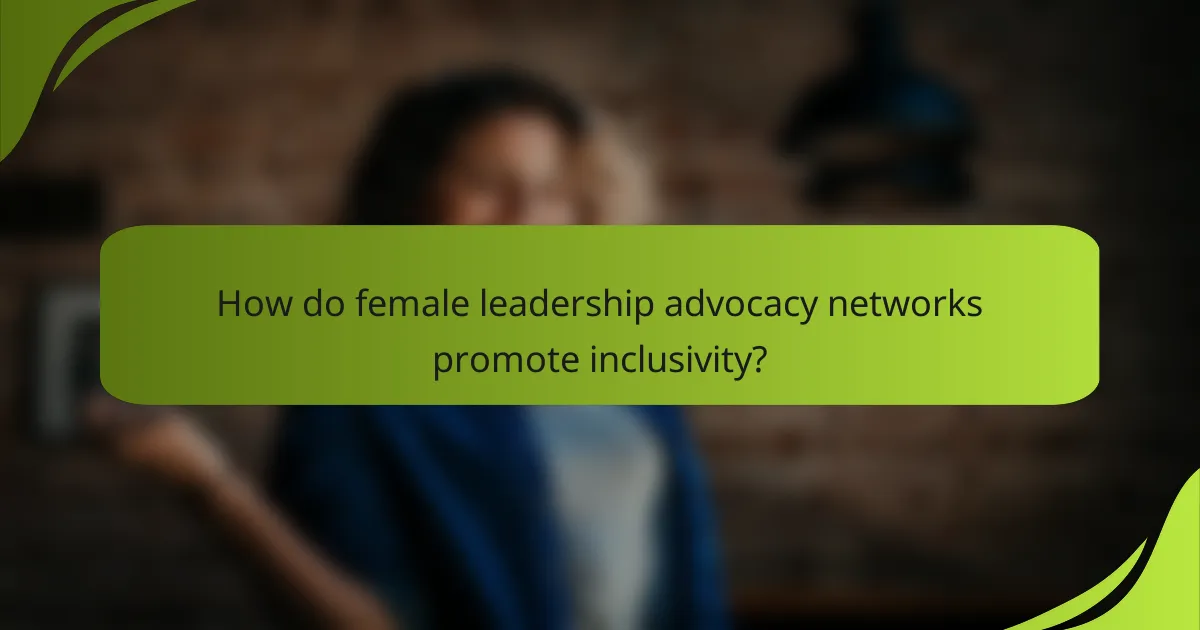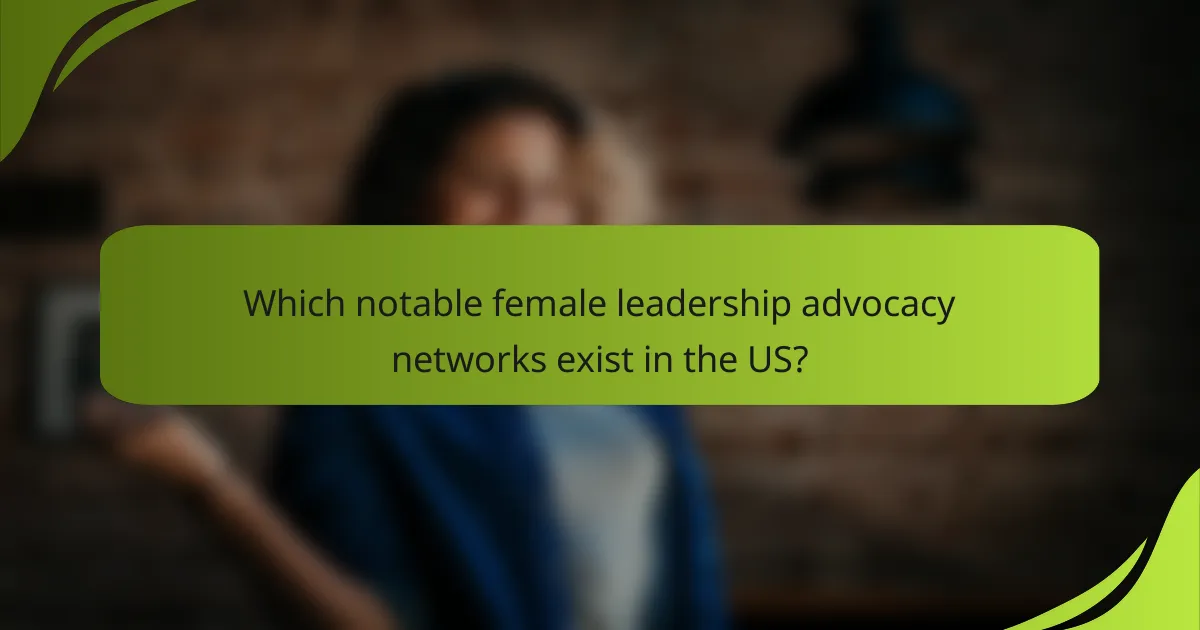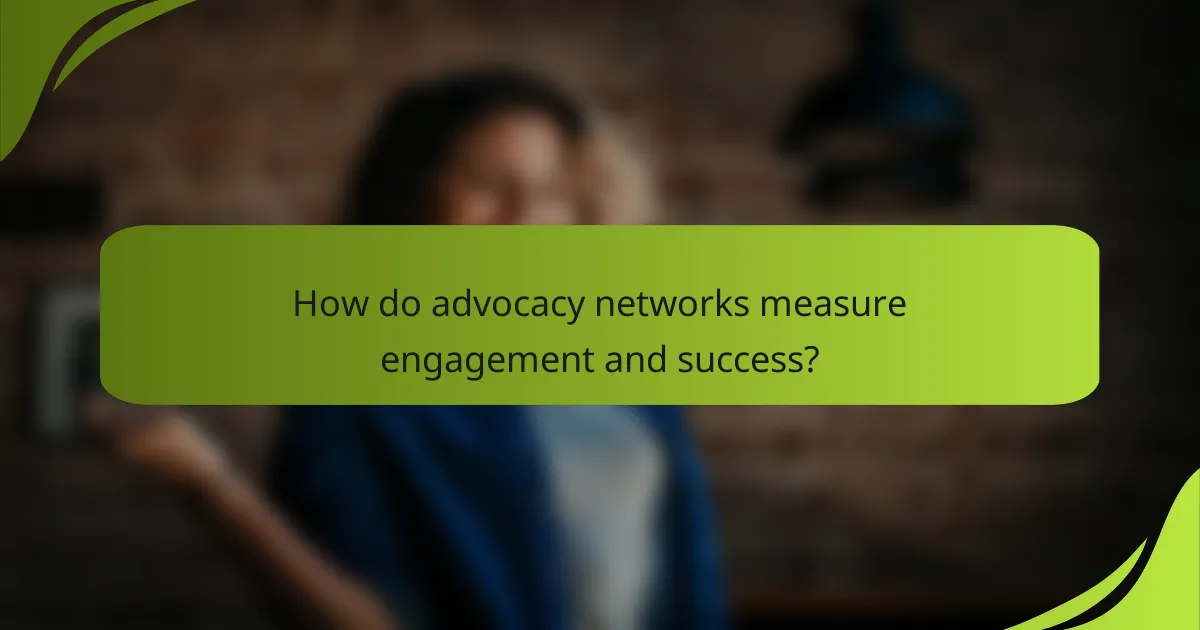Female leadership advocacy networks play a crucial role in promoting inclusivity and diversity by providing platforms for underrepresented women to connect and share their experiences. By fostering environments that encourage active participation, these networks not only enhance creativity and problem-solving but also improve overall organizational performance. Engaging with these networks through strategic partnerships and supportive initiatives can significantly benefit both organizations and the communities they serve.

How do female leadership advocacy networks promote inclusivity?
Female leadership advocacy networks promote inclusivity by creating spaces where underrepresented women can connect, share experiences, and access resources tailored to their needs. These networks focus on fostering an environment that values diversity and encourages active participation from all members.
Programs for underrepresented women
Programs specifically designed for underrepresented women often include workshops, training sessions, and networking events that address unique challenges faced by these individuals. These initiatives aim to equip participants with skills and knowledge that enhance their leadership capabilities.
For example, a network might offer a series of workshops on negotiation skills or public speaking, targeting women from diverse backgrounds. Such programs can significantly boost confidence and prepare participants for leadership roles.
Mentorship opportunities
Mentorship is a key component of female leadership advocacy networks, providing underrepresented women with access to experienced leaders who can offer guidance and support. These mentorship programs typically match mentees with mentors based on shared interests and career goals.
Effective mentorship can lead to increased visibility and opportunities for advancement. Networks often encourage regular check-ins and goal-setting to ensure that the mentorship relationship remains productive and focused.
Inclusive policy advocacy
Inclusive policy advocacy involves actively promoting policies that support gender equity and diversity in leadership positions. Advocacy efforts may include lobbying for legislative changes, raising awareness about systemic barriers, and collaborating with organizations that share similar goals.
For instance, networks might campaign for policies that mandate diversity in corporate boards or support family-friendly workplace practices. Engaging in these advocacy efforts not only amplifies the voices of underrepresented women but also drives systemic change in various sectors.

What are the benefits of diversity in leadership?
Diversity in leadership brings numerous advantages, including enhanced creativity, better problem-solving, and increased employee satisfaction. Organizations that prioritize diverse leadership often experience improved decision-making and performance metrics.
Enhanced decision-making
Diverse leadership teams are better equipped to make informed decisions due to the variety of perspectives they encompass. This range of viewpoints helps to identify potential pitfalls and opportunities that a homogenous group might overlook.
For instance, a team with members from different cultural backgrounds can approach challenges with unique solutions, leading to more comprehensive and effective strategies. Organizations should actively seek to include individuals with varying experiences to maximize decision-making capabilities.
Improved organizational performance
Organizations with diverse leadership often see a direct correlation with improved performance metrics. Studies suggest that companies with diverse leadership teams can achieve higher profitability and productivity compared to their less diverse counterparts.
For example, firms in the top quartile for gender diversity on executive teams are statistically more likely to outperform their peers in terms of profitability. Companies should track performance data to assess the impact of diversity initiatives on their bottom line.
Broader perspectives
Leadership diversity fosters broader perspectives, which can lead to innovative solutions and better customer understanding. When leaders come from various backgrounds, they can connect with a wider audience and address diverse customer needs effectively.
Organizations should encourage diverse hiring practices and create inclusive environments where all voices are heard. This approach not only enhances creativity but also strengthens brand loyalty as customers feel represented and understood.

How can organizations engage with female leadership networks?
Organizations can effectively engage with female leadership networks by forming strategic partnerships, participating in relevant events, and supporting initiatives that promote inclusivity and diversity. These actions foster collaboration and enhance visibility for both the organizations and the networks involved.
Partnerships with established networks
Forming partnerships with established female leadership networks allows organizations to leverage existing resources and expertise. These collaborations can include co-hosting events, sharing best practices, and providing mentorship opportunities. Organizations should seek networks that align with their values and goals to ensure a mutually beneficial relationship.
Consider reaching out to local or national networks that focus on specific industries or demographics. This targeted approach can enhance engagement and lead to more meaningful connections within the community.
Participation in events and workshops
Active participation in events and workshops organized by female leadership networks is crucial for building relationships and demonstrating commitment. Organizations can send representatives to attend, speak, or sponsor these events, which often cover topics like leadership development, career advancement, and networking strategies.
Look for events that offer interactive sessions or panel discussions, as these provide opportunities for direct engagement and feedback. Organizations should aim to participate regularly to maintain visibility and strengthen ties with the network.
Support for initiatives
Supporting initiatives led by female leadership networks can take many forms, including financial contributions, resource sharing, or employee volunteering. Organizations should identify initiatives that resonate with their mission and values, such as mentorship programs or scholarship funds for aspiring female leaders.
Consider creating a formal program that encourages employees to engage with these initiatives, such as matching donations or providing paid time off for volunteering. This not only enhances the organization’s reputation but also fosters a culture of inclusivity and support for diversity in leadership.

What criteria should organizations consider when selecting advocacy networks?
Organizations should evaluate advocacy networks based on their alignment with core values, proven success, and the impact they have on the community. These criteria ensure that the selected networks effectively promote inclusivity and diversity while engaging stakeholders meaningfully.
Alignment with organizational values
When selecting advocacy networks, it is crucial to ensure that their mission and objectives resonate with your organization’s core values. This alignment fosters a cohesive approach to advocacy, enhancing credibility and support from both internal and external stakeholders.
For example, if an organization prioritizes sustainability, partnering with networks that advocate for environmental justice can amplify their efforts. A clear alignment can also streamline communication and collaboration, making initiatives more effective.
Track record of success
Assessing the track record of advocacy networks is essential to gauge their effectiveness and reliability. Look for networks that have demonstrated measurable outcomes, such as increased representation of women in leadership roles or successful policy changes that promote inclusivity.
Organizations can review case studies, testimonials, and performance metrics to evaluate past successes. A network with a strong history of achieving its goals is more likely to deliver results in future collaborations.
Community impact
The impact of advocacy networks on the community should be a key consideration. Evaluate how these networks engage with local populations and contribute to social change. Their ability to mobilize resources and support grassroots initiatives can significantly enhance community well-being.
Consider networks that actively involve community members in decision-making processes and provide opportunities for leadership development. This engagement not only strengthens the community but also aligns with the broader goals of diversity and inclusivity.

Which notable female leadership advocacy networks exist in the US?
In the US, several prominent female leadership advocacy networks focus on promoting inclusivity, diversity, and engagement among women in leadership roles. These organizations provide resources, mentorship, and community support to empower women and advance gender equity in various sectors.
Lean In
Lean In is a global community dedicated to empowering women to achieve their ambitions and create an equal world. Founded by Sheryl Sandberg, it offers a wealth of resources including online courses, discussion groups, and a supportive network that encourages women to share their experiences and challenges.
Members can participate in local chapters, which host events and workshops aimed at building skills and confidence. Lean In’s focus on practical advice and peer support helps women navigate workplace dynamics and advance their careers effectively.
Women in Leadership Nexus
The Women in Leadership Nexus (WILN) is a network that connects women leaders across various industries to foster collaboration and mentorship. WILN emphasizes the importance of building relationships and sharing knowledge to enhance women’s leadership capabilities.
Through events, webinars, and a resource library, WILN provides tools and strategies for women to elevate their leadership presence. The network encourages members to engage actively and leverage their collective experiences to drive change within their organizations.
National Organization for Women
The National Organization for Women (NOW) is one of the largest feminist organizations in the US, advocating for women’s rights and equality. NOW focuses on a broad range of issues, including workplace equality, reproductive rights, and ending violence against women.
Members can participate in advocacy campaigns, educational programs, and local chapters that work on specific issues relevant to their communities. NOW’s grassroots approach empowers women to take action and influence policy changes at local, state, and national levels.

How do advocacy networks measure engagement and success?
Advocacy networks gauge engagement and success through various metrics that reflect member involvement and the impact of their initiatives. Key indicators include participation rates and the results of impact assessments, which help organizations understand their effectiveness and areas for improvement.
Member participation rates
Member participation rates are a primary metric for assessing engagement within advocacy networks. These rates can be measured through attendance at events, involvement in initiatives, and contributions to discussions. A healthy participation rate typically ranges from 30% to 70% of the total membership, depending on the network’s size and activity level.
To enhance participation, networks should consider offering flexible meeting times, virtual engagement options, and incentives for active involvement. Regularly communicating the value of participation can also motivate members to engage more fully.
Impact assessments
Impact assessments evaluate the effectiveness of advocacy efforts and the extent to which goals are met. These assessments can include surveys, feedback from members, and analysis of policy changes influenced by the network. A well-structured impact assessment process often involves setting clear objectives and measuring outcomes against these benchmarks.
Networks should conduct impact assessments periodically, ideally annually, to track progress and adapt strategies as needed. Utilizing both qualitative and quantitative data will provide a comprehensive view of the network’s success and areas that require attention.


